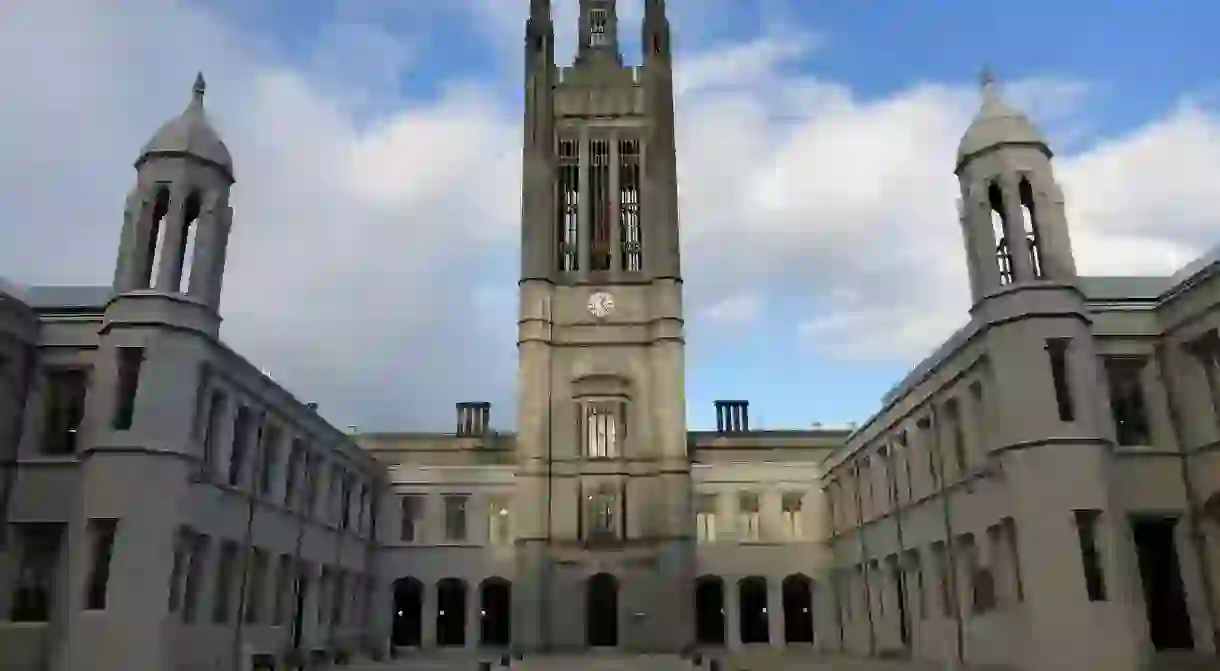A Walking Tour of Aberdeen's Architectural Landmarks

For lovers of architecture the Granite City is a wonder. Many of Aberdeen’s iconic buildings date from the mid 18th to mid 20th centuries, when new technological advances enabled a stream of grand designs and ornamental façades to tie the city together and, ultimately, to form the sense of a whole that we see now. A great way to get up close and personal with some of these landmarks is to walk between them. Come with us on this tour (via Google Maps below), as we point out the must-see and cannot-miss buildings in the centre of Scotland‘s third city, in writing, images, and the map at the end of this guide.
Union Terrace (1)
Our short walk begins at the corner of Union Terrace and Union Street, next to the gardens. The building here exhibits beautiful Doric columns — if you look up you can see the amount of effort that went into the decoration of these commercial properties. This particular example was built in 1885.

Union Bridge (2)
Constructed between 1801 and 1805, Union Bridge was designed to create a majestic entrance to the city, while also raising the road and city up from the dirty water of the Denburn valley below. Possessing the claim to fame of being the longest single-span granite bridge in the world, much has altered in Aberdeen since this thoroughfare was created, but Union Street remains a major artery into the city.
St. Nicholas Kirk Screen (3)
On the left as you walk along Union Street you will see an array of twelve granite columns, designed in 1829 by the architect John Smith. These mark the southern edge of the kirkyard of St. Nicholas Uniting, whose granite spire can be seen rising behind the trees.

New Town House and Tolbooth (4)
Constructed in the 19th century, the New Town House is granite, and the older 17th century Tolbooth is sandstone. This gives you the chance to see the two different stones together and examine the differences. The Tolbooth was a former prison, once used to house Jacobite prisoners and is allegedly the site of a number of hauntings. Today it is a museum.
Marischal College (5)
Recently cleaned, this building is simply stunning in the sunlight, when it glistens and sparkles. The second largest granite building anywhere in the world, behind El Escorial, near Madrid, Marischal College is definitely an architectural highlight of Aberdeen and, arguably, Scotland.

Provost Skene’s House (6)
Parts of this building date from the 1500s, and it gives a rare glimpse into the very earliest use of granite as a building material, before the industrial age altered the methods in which it could be utilised.
The Kirk of St. Nicholas Uniting
Another angle of this church. The oldest known mention of the building was in 1157, but the construction has altered many times since then. The site of a extensive archaeological dig, St. Nicholas has taught much about medieval Aberdeen. It is still in use as a place of worship today.

Robert Gordon’s College (7)
This is an optional portion of the walk, as it can easily be cut out by simply continuing along Schoolhill. Indeed, it is possible to see much of the college by doing so, and peeking in through the main archway entrance — but a walk around the site affords glimpses of other angles, of the buildings behind and around the college, and also gives a good sense of scale, especially when you turn the corner back towards Schoolhill and Rosemount Viaduct, and the domes, arches, and spires of Aberdeen appear to surround you.
Art Gallery (8)
The art gallery is due to reopen in 2017 following extensive renovations and updates, and is definitely worth a look. The stonework inside includes 28 columns, each of which has been polished, and made from a different variety of granite; some local and some imported from further afield, brought to be worked in the Aberdeen granite industry.
His Majesty’s Theatre (9)
Designed by Frank Matcham and opened in 1906, His Majesty’s Theatre is a beautiful Category A listed building. When opened it could seat 2,300 people on four different levels, and is once again in use as a theatre and arts venue. Along with Saint Mark’s and the library, His Majesty’s starts a wonderful row of exceptional buildings that complement each other perfectly.

Saint Mark’s (10)
Blocky and bulky, the stonework of St. Mark’s church is imposing and a fine counterpoint to the more delicate theatre next door. The portico, drum, and dome were modelled on Saint Paul’s Cathedral in London.
Central Library (11)
Opened by Andrew Carnegie in 1892, this library had been in use ever since. The curves, archways and wonderfully framed windows and doors are reflected within the architecture of the constructions of Saint Mark’s and His Majesty’s Theatre. The effect is marvellous, creating a row of buildings that would be hard to surpass.
Rosemount Viaduct (12)
This whole road has many delights, not least the three buildings listed previously. Others include the flatiron building opposite the library, or the array of balconies and impressive chimney stacks. Although Aberdeen has some mighty and incredible buildings, many of the best bits are to be found in the tiny details, showing the level of care and planning that went into creating the whole. Rosemount Viaduct is a good example of this, and a fitting place to end our wee walk.

Bonus features
As you walk, do keep an eye both up and down (being careful of traffic and other pedestrians, of course!) Up because the rooftops and gables harbour beautiful carvings and decoration, and down because the streets sometimes still exhibit the granite stone setts that used to provide such an enduring surface for countless horses, carriages and carts. A wonderful example of the latter can be found down Correction Wynd, just beyond the screen at the southern end of St. Nicholas Kirkyard.














